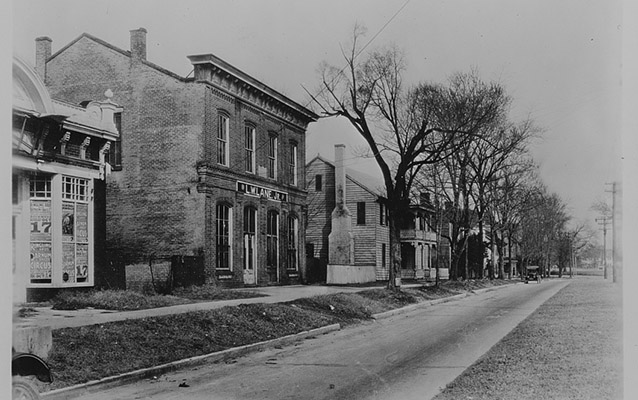Last updated: August 20, 2018
Place
Williamsburg, VA

From the collections of the Library of Congress (https://www.loc.gov/item/2017872175/).
Quick Facts
Location:
Williamsburg, Virginia
Designation:
National Historic Landmark District
MANAGED BY:
Williamsburg Historic District is one of the most ambitious restoration projects in the country. It was begun in 1927 under the auspices of John D. Rockefeller, Jr.; to date, some 600 buildings have been razed or removed, approximately 100 restored, and about 350 reconstructed on their original sites. Noteworthy restorations include: the Public Magazine (1714), the Ludwell-Paradise House (1717), the Old Courthouse (1770), Bruton Parish Church (1710-15), and the George Wythe House (1755). Old College Yard, standing at the western end of the main thoroughfare, Gloucester Street, has also been restored—the so-called "Wren Building" (1695-1702), Brafferton Hall (1723), and the President's House (1770). Old College Yard is a separate landmark, yet is integral to Williamsburg, balancing as it does the Colonial Capitol Building (1701-05) at the other end of Gloucester Street. Some ambitious reconstructions other than the Capitol include Raleigh Tavern (c. 1742) and the Governor's Palace (1706-20). The design for most of these buildings is rigidly geometric in the early Georgian style.
Williamsburg began as a palisaded barrier called Middle Plantation in 1633. In 1699 it became the capital of Virginia, and was renamed ' in honor of William III, then king of England. For eighty years it was a political and cultural center of American life. It proved an excellent ideological training ground for men who would later take leading roles in the establishment of an independent American nation: George Washington, Patrick Henry, George Wythe, Thomas Jefferson, and George Mason all either studied, taught, or served in office at Williamsburg.
The House of Burgesses, in the Capitol Building at Williamsburg, was the scene of Patrick Henry's famous "Caesar-Brutus" speech: "Caesar had his Brutus, Charles the First his Cromwell, and George the Third... George the Third," he shouted, as cries of 'treason.'' filled the room, "should profit by their example. If this be treason gentlemen, make the most of it." Henry's angry Stamp Act Resolutions were offered here as well.
George Mason wrote the Virginia Declaration of Rights in Williamsburg, and on May 15, 1776, its Resolution for Independence. This document led directly to a similar declaration by the Continental Congress on July 4. The Virginia Constitution of 1776 was drawn up in Williamsburg following Virginia's Declaration of Independence with the other colonies in July. This constitution served as a model for many other new states.
Thomas Jefferson's Statute for Religious Freedom was introduced in Williamsburg; as Governor of Virginia he made William and Mary the country's first true university in 1791. The College, founded in 1693, is the nation's second oldest. In 1779 the capital was moved to Richmond and Williamsburg declined steadily in influence and wealth from that time on.
Williamsburg Historic District was listed on the National Register of Historic Places on October 15, 1966. It was designated a National Historic Landmark District on October 9, 1960.
Many of the buildings in and around Williamsburg have been recorded by the Historic American Buildings Survey. These documents are held by the Library of Congress.
Read the full nomination.
Learn more about the National Register of Historic Places.
Learn more about the National Historic Landmarks Program.
Learn more about the Historic American Buildings Survey.
Williamsburg began as a palisaded barrier called Middle Plantation in 1633. In 1699 it became the capital of Virginia, and was renamed ' in honor of William III, then king of England. For eighty years it was a political and cultural center of American life. It proved an excellent ideological training ground for men who would later take leading roles in the establishment of an independent American nation: George Washington, Patrick Henry, George Wythe, Thomas Jefferson, and George Mason all either studied, taught, or served in office at Williamsburg.
The House of Burgesses, in the Capitol Building at Williamsburg, was the scene of Patrick Henry's famous "Caesar-Brutus" speech: "Caesar had his Brutus, Charles the First his Cromwell, and George the Third... George the Third," he shouted, as cries of 'treason.'' filled the room, "should profit by their example. If this be treason gentlemen, make the most of it." Henry's angry Stamp Act Resolutions were offered here as well.
George Mason wrote the Virginia Declaration of Rights in Williamsburg, and on May 15, 1776, its Resolution for Independence. This document led directly to a similar declaration by the Continental Congress on July 4. The Virginia Constitution of 1776 was drawn up in Williamsburg following Virginia's Declaration of Independence with the other colonies in July. This constitution served as a model for many other new states.
Thomas Jefferson's Statute for Religious Freedom was introduced in Williamsburg; as Governor of Virginia he made William and Mary the country's first true university in 1791. The College, founded in 1693, is the nation's second oldest. In 1779 the capital was moved to Richmond and Williamsburg declined steadily in influence and wealth from that time on.
Williamsburg Historic District was listed on the National Register of Historic Places on October 15, 1966. It was designated a National Historic Landmark District on October 9, 1960.
Many of the buildings in and around Williamsburg have been recorded by the Historic American Buildings Survey. These documents are held by the Library of Congress.
Read the full nomination.
Learn more about the National Register of Historic Places.
Learn more about the National Historic Landmarks Program.
Learn more about the Historic American Buildings Survey.
